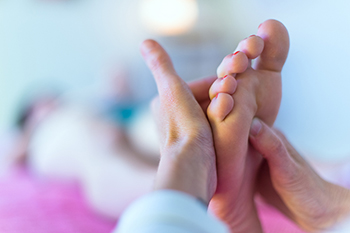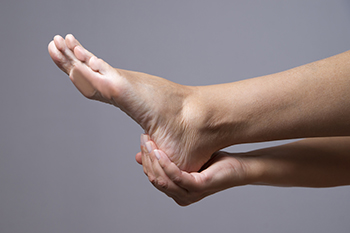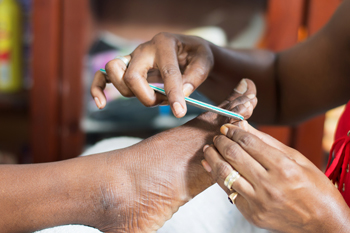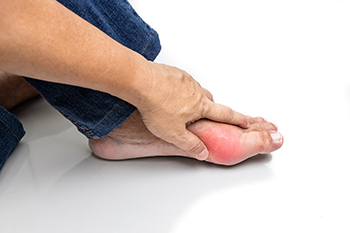

Many different foot afflictions primarily impact a bone in the feet. Cuboid syndrome is one such condition, and it primarily targets the cuboid bone. The cuboid bone is a cube-shaped bone on the outer side of the foot. When it moves out of alignment, this is known as cuboid syndrome. There are several different ways that a medical professional might go about treating cuboid syndrome. One common way is by performing what is known as a “cuboid whip,” which is essentially a manual manipulation of the bone back into alignment. The medical professional can perform this manual procedure by making the patient lie down, relax the leg, and extend the knee while the professional pops the cuboid bone back into place. As a result of this manipulation, the patient might hear some kind of pop sound when the bone shifts back into place. Contact a podiatrist today for more information.
Cuboid syndrome, also known as cuboid subluxation, occurs when the joints and ligaments near the cuboid bone in the foot become torn. If you have cuboid syndrome, consult with the podiatrists from The Foot & Ankle Center of New Jersey. Our doctors will assess your condition and provide you with quality foot and ankle treatment.
Cuboid syndrome is a common cause of lateral foot pain, which is pain on the outside of the foot. The condition may happen suddenly due to an ankle sprain, or it may develop slowly overtime from repetitive tension through the bone and surrounding structures.
Causes
The most common causes of cuboid syndrome include:
Symptoms
A common symptom of cuboid syndrome is pain along the outside of the foot which can be felt in the ankle and toes. This pain may create walking difficulties and may cause those with the condition to walk with a limp.
Diagnosis
Diagnosis of cuboid syndrome is often difficult, and it is often misdiagnosed. X-rays, MRIs and CT scans often fail to properly show the cuboid subluxation. Although there isn’t a specific test used to diagnose cuboid syndrome, your podiatrist will usually check if pain is felt while pressing firmly on the cuboid bone of your foot.
Treatment
Just as the range of causes varies widely, so do treatments. Some more common treatments are ice therapy, rest, exercise, taping, and orthotics.
If you have any questions, please feel free to contact our office located in Paramus, NJ . We offer the newest diagnostic and treatment technologies for all your foot care needs.

People who have cracked heels may notice they become worse in the colder months. This condition can cause your feet to look older and may be painful or uncomfortable. There are various reasons why cracked heels can develop, including standing on hard surfaces and wearing shoes that have an open back. Flip flops and sandals also fall into this category and if you choose to wear this shoe, it helps if it has a strap to secure the heel. People who are obese may find they have cracked heels due to the added weight the heels endure. Medical conditions like eczema, psoriasis, and thyroid disorders may lead to cracked heels. Some of the symptoms that are associated with this ailment include redness, flaky skin, and in severe cases, the cracks in the heel may bleed causing an infection. There are several treatment methods for cracked heels and if you suffer from this condition, it is advised that you consult a podiatrist who can help you with effective healing techniques.
Cracked heels are unsightly and can cause further damage to your shoes and feet. If you have any concerns, contact the podiatrists from The Foot & Ankle Center of New Jersey. Our doctors can provide the care you need to keep you pain-free and on your feet.
Cracked Heels
Cracked heels appear unappealing and can make it harder for you walk around in sandals. Aside from looking unpleasant, cracked heels can also tear stockings, socks, and wear out your shoes. There are several methods to help restore a cracked heel and prevent further damage.
How Do You Get Them?
Dry skin is the number one culprit in creating cracked heels. Many athletes, walkers, joggers, and even swimmers suffer from cracked heels. Age and skin oil production play a role to getting cracked heels as well.
Promote Healing
Over the counter medicines can help, especially for those that need instant relief or who suffer from chronic dry feet.
Wear Socks – Wearing socks with medicated creams helps lock in moisture.
Moisturizers – Applying both day and night will help alleviate dryness which causes cracking.
Pumice Stones – These exfoliate and remove dead skin, which allows for smoother moisturizer application and better absorption into the skin.
Change in Diet
Eating healthy with a well-balanced diet will give the skin a fresh and radiant look. Your body responds to the kinds of food you ingest. Omega-3 fatty acids and zinc supplements can also revitalize skin tissue.
Most importantly, seek professional help if unsure how to proceed in treating cracked heels. A podiatrist will help you with any questions or information needed.
If you have any questions, please feel free to contact our office located in Paramus, NJ . We offer the newest diagnostic and treatment technologies for all your foot care needs.

One of the noticeable symptoms of toenail fungus is yellowed nails. The nails can also become thickened and brittle, and in severe cases, fall off. The name of the fungus is known as onychomycosis and research has shown it accounts for approximately 50 percent of nail problems. Older people are more prone to developing toenail fungus than the younger population, and this may be a result of reduced blood flow that happens as the aging process occurs. This type of fungus lives and thrives in warm and moist environments, including shower room floors, locker rooms, and public swimming pool areas. The fungus can enter the body through tiny cracks in the skin and it is wise to wear appropriate shoes while in these areas. Existing medical conditions like eczema, psoriasis, and diabetes may lead to the development of toenail fungus. If you see signs of toenail fungus, please contact a podiatrist who can guide you toward the correct treatment process which varies by person.
For more information about treatment, contact the podiatrists of The Foot & Ankle Center of New Jersey. Our doctors can provide the care you need to keep you pain-free and on your feet.
Toenail Fungus Treatment
Toenail fungus is a condition that affects many people and can be especially hard to get rid of. Fortunately, there are several methods to go about treating and avoiding it.
Antifungals & Deterrence
Oral antifungal medicine has been shown to be effective in many cases. It is important to consult with a podiatrist to determine the proper regiment for you, or potentially explore other options.
Applying foot powder on the feet and shoes helps keep the feet free of moisture and sweat.
Sandals or open toed shoes – Wearing these will allow air movement and help keep feet dry. They also expose your feet to light, which fungus cannot tolerate. Socks with moisture wicking material also help as well.
If you have any questions please feel free to contact our office located in Paramus, NJ . We offer the newest diagnostic tools and technology to treat your foot and ankle needs.

Foot massages have many benefits and may relieve existing foot pain. Reflexology and massages are performed on the feet and can positively affect the organs in the body. There are differences between the two types of foot therapy. Foot massages can be described as more of a general term for manual techniques that are applied to the feet, and this differs from reflexology in which specific practices and theories are applied. Foot reflexology uses the pressure points on the feet that correspond to various organs in the body. This can be helpful in stimulating the central nervous system which may help to promote healing. Additionally, there may be different types of foot massages, including Swedish, Shiatsu, and Thai massages. Having any type of these massages may improve circulation, reduce muscle tension, and reduce stress and pain. If you would like more information about the benefits of these types of foot therapies, please contact a podiatrist who can answer any questions you may have.
Foot therapy is often necessary for those recovering from either foot deformities or foot injuries. If you have concerns regarding therapy, consult with the podiatrists from The Foot & Ankle Center of New Jersey. Our doctors can provide the care you need to keep you pain-free and on your feet.
Most Common Injuries
People who are active or athletes are prone to a variety of injuries. Therefore, it is often important to take part in physical therapy in order to quickly get back on the right track.
What to Do When Injured
Physical Therapy – This specialized treatment will focus on the affected area, speeding up recovery and the overall healing process. It is a proven method that has helped millions of people return from any injury.
During physical therapy you will undergo regimented training to get back into full form. Training is often very difficult, especially at first when the foot feels weak. Physical therapy often involves:
Basic stretching and twisting exercises – getting the feet’s mobility and flexibility up.
Massaging – the therapist will massage the injured area in order to activate the muscles and relax them.
Strengthening Exercises – this allows the muscles in the affected area to regain their full strength, a vital step towards full recovery.
If you have any questions please feel free to contact our office located in Paramus, NJ . We offer the newest diagnostic tools and technology to treat your foot and ankle needs.

The arches of the feet work as a spring that bears the weight of your body whenever you take a step. Most people are familiar with the arch on the inner sole of the midfoot. However, three separate arches combine to form a triangle in the feet that absorb the shock of walking and running. There are two longitudinal arches, medial and lateral, that run along either side of the foot from the heel to the top of the 1st and 5th metatarsal. Plus there is a transverse arch that runs across the midfoot, connecting the tops of the metatarsals. These three arches are supported by a number of ligaments, muscles, tendons, and bones that all help to support the weight of the body. When the medial longitudinal arch is too high, it causes a condition called pes cavus, which can be painful and cause gait problems. When the longitudinal arches collapse, it results in flat feet, known as pes planus. Both conditions, which can affect the way you carry out your daily activities, can be diagnosed and treated by a podiatrist.
If you have any concerns about your feet, contact the podiatrists from The Foot & Ankle Center of New Jersey. Our doctors can provide the care you need to keep you pain-free and on your feet.
Biomechanics in Podiatry
Podiatric biomechanics is a particular sector of specialty podiatry with licensed practitioners who are trained to diagnose and treat conditions affecting the foot, ankle and lower leg. Biomechanics deals with the forces that act against the body, causing an interference with the biological structures. It focuses on the movement of the ankle, the foot and the forces that interact with them.
A History of Biomechanics
Modern technological improvements are based on past theories and therapeutic processes that provide a better understanding of podiatric concepts for biomechanics. Computers can provide accurate information about the forces and patterns of the feet and lower legs.
Understanding biomechanics of the feet can help improve and eliminate pain, stopping further stress to the foot.
If you have any questions please feel free to contact our office located in Paramus, NJ . We offer the newest diagnostic and treatment technologies for all your foot and ankle needs.

Many people connect that the quality of their life is based on how good their feet feel. They are the foundation of the body, and completing daily activities may be difficult with aching feet. Additionally, poor foot health may limit exercise completely, or limit the amount of time spent practicing it. There are simple habits that can ensure healthy feet when everyday foot care techniques are enforced. These start with washing and drying the feet thoroughly, followed by applying a good moisturizer on them. It is beneficial to have the toenails properly trimmed, and this can be done by having regular pedicures done, or by cutting them at home using a stainless steel clipper. The feet will feel good when they are soaked in warm water at the end of the day, which may have a soothing effect on the overall body. Additionally, the type of shoes that are worn contributes significantly to how the feet feel. It is beneficial to wear shoes that are the correct size, have ample room for the toes to move freely in, and are comfortable. If you would like to have additional tips on following a daily foot care routine, please confer with a podiatrist.
Everyday foot care is very important to prevent infection and other foot ailments. If you need your feet checked, contact the podiatrists from The Foot & Ankle Center of New Jersey. Our doctors can provide the care you need to keep you pain-free and on your feet.
Everyday Foot Care
Often, people take care of their bodies, face and hair more so than they do for their feet. But the feet are a very important aspect of our bodies, and one that we should pay more attention to. Without our feet, we would not be able to perform most daily tasks.
It is best to check your feet regularly to make sure there are no new bruises or cuts that you may not have noticed before. For dry feet, moisturizer can easily be a remedy and can be applied as often as necessary to the affected areas. Wearing shoes that fit well can also help you maintain good foot health, as well as making it easier to walk and do daily activities without the stress or pain of ill-fitting shoes, high heels, or even flip flops. Wearing clean socks with closed shoes is important to ensure that sweat and bacteria do not accumulate within the shoe. Clean socks help to prevent Athlete’s foot, fungi problems, bad odors, and can absorb sweat.
If you have any questions please feel free to contact our office located in Paramus, NJ . We offer the newest diagnostic and treatment technologies for all your foot and ankle needs.

In the first few years of a child’s life, the bones in their feet develop from soft areas of cartilage, known as growth plates. Once the growth plate fully develops, the bones do not grow any further. The heel bone grows until about the age of 15. A child between the ages of 9 and 15 who is physically active may develop a condition known as Sever’s disease. This is simply an imbalance between the growth of the heel bone and the soft tissue. The result is pain around the heel, which is made worse by running or standing on tiptoes. It is nearly impossible to detect Sever’s disease from an X-ray, but the symptoms usually are enough to make an accurate diagnosis. Relief from Sever’s disease comes from ceasing the activity that caused it and resting the foot. Heel pads and splinting at night can help to reduce the pain. For more information about Sever’s disease, please check with a podiatrist.
Sever's disease often occurs in children and teens. If your child is experiencing foot or ankle pain, see the podiatrists from The Foot & Ankle Center of New Jersey. Our doctors can treat your child’s foot and ankle needs.
Sever’s Disease
Sever’s disease is also known as calcaneal apophysitis, which is a medical condition that causes heel pain I none or both feet. The disease is known to affect children between the ages of 8 and 14.
Sever’s disease occurs when part of the child’s heel known as the growth plate (calcaneal epiphysis) is attached to the Achilles tendon. This area can suffer injury when the muscles and tendons of the growing foot do not keep pace with bone growth. Therefore, the constant pain which one experiences at the back of the heel will make the child unable to put any weight on the heel. The child is then forced to walk on their toes.
Symptoms
Acute pain – Pain associated with Sever’s disease is usually felt in the heel when the child engages in physical activity such as walking, jumping and or running.
Highly active – Children who are very active are among the most susceptible in experiencing Sever’s disease, because of the stress and tension placed on their feet.
If you have any questions, please feel free to contact our office located in Paramus, NJ . We offer the newest diagnostic and treatment technologies for all your foot and ankle injuries.

People who experience gout attacks often find completing daily tasks difficult to do. This is a result of the severe pain and discomfort gout can cause, and many people often seek prompt medical attention. It can occur from genetic reasons, or from eating foods that have high levels of purines like red meat, shellfish, and alcoholic drinks. Purines cause excess uric acid to lodge between the joints in the big toe which can be likened to a sensation of crystals that is felt in the toes. This feeling can produce severe pain and discomfort, and daily activities are often ceased until it subsides. Gout may target specific groups of people, including men over 40 years old, overweight people, or possibly those having kidney disease. Effective prevention techniques can consist of reducing the amount of alcohol that is consumed, drinking plenty of water, and generally eating healthy foods. If you have frequent gout attacks, it is strongly urged that you are under the care of a podiatrist who can determine what the reason is, and offer you the correct treatment options.
Gout is a painful condition that can be treated. If you are seeking treatment, contact the podiatrists from The Foot & Ankle Center of New Jersey. Our doctors will treat your foot and ankle needs.
What Is Gout?
Gout is a form of arthritis that is characterized by sudden, severe attacks of pain, redness, and tenderness in the joints. The condition usually affects the joint at the base of the big toe. A gout attack can occur at any random time, such as the middle of the night while you are asleep.
Symptoms
Risk Factors
Prior to visiting your podiatrist to receive treatment for gout, there are a few things you should do beforehand. If you have gout you should write down your symptoms--including when they started and how often you experience them, important medical information you may have, and any questions you may have. Writing down these three things will help your podiatrist in assessing your specific situation so that he or she may provide the best route of treatment for you.
If you have any questions, please feel free to contact our office located in Paramus, NJ . We offer the newest diagnostic and treatment technologies for all your foot care needs.

A plantar wart, also called a verruca, is believed to be caused by the human papillomavirus (HPV) and results in the buildup of keratin on the skin. This shows up as a wart. Because HPV thrives in warm, moist environments, it may be spread by walking barefoot around swimming pools or gym locker rooms. It frequently enters through a crack or sore on the bottom of the foot. Plantar warts often cause pain, which can be felt when putting weight on the foot. Other symptoms include thickened skin that appears to be a callus and black dots, which are actually dried blood trapped in the capillaries. Sometimes, white or skin-colored lesions appear on the sole of the foot. Plantar warts often go away on their own, but the foot may be re-exposed if proper footwear is not used in situations where HPV is likely to be found. A podiatrist can offer a number of treatment options to remove a plantar wart. Among them are burning off the wart with salicylic acid, freezing the wart, or cutting the wart out. For more information, please consult a podiatrist.
Plantar warts can be very uncomfortable. If you need your feet checked, contact the podiatrists from The Foot & Ankle Center of New Jersey. Our doctors will assist you with all of your foot and ankle needs.
About Plantar Warts
Plantar warts are the result of HPV, or human papillomavirus, getting into open wounds on the feet. They are mostly found on the heels or balls of the feet.
While plantar warts are generally harmless, those experiencing excessive pain or those suffering from diabetes or a compromised immune system require immediate medical care. Plantar warts are easily diagnosed, usually through scraping off a bit of rough skin or by getting a biopsy.
Symptoms
Treatment
To help prevent developing plantar warts, avoid walking barefoot over abrasive surfaces that can cause cuts or wounds for HPV to get into. Avoiding direct contact with other warts, as well as not picking or rubbing existing warts, can help prevent the further spread of plantar warts. However, if you think you have developed plantar warts, speak to your podiatrist. He or she can diagnose the warts on your feet and recommend the appropriate treatment options.
If you have any questions please feel free to contact our office located in Paramus, NJ . We offer the newest diagnostic and treatment technologies for all your foot and ankle needs.